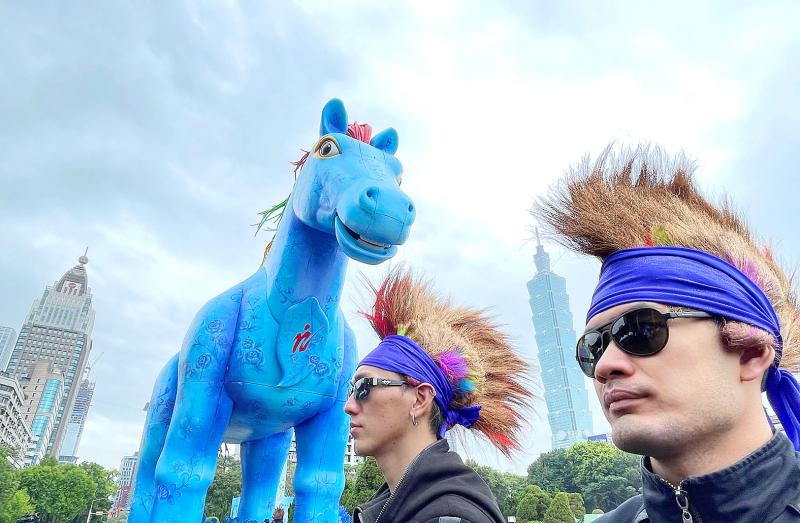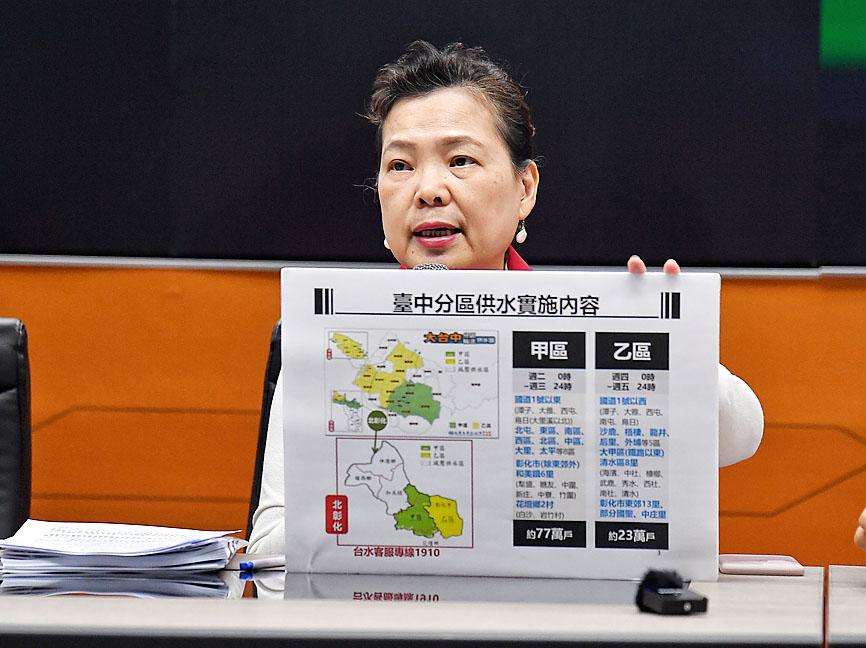Recent rains in central and southern Taiwan have not refilled water reservoirs, prompting the Ministry of Economic Affairs (MOEA) to announce that next month would bring further water restrictions to some parts of the nation.
Some areas of Miaoli County and Taichung are to be placed on “red alert,” meaning that water supplies to households and businesses would be on for five days and off for two days, the ministry said yesterday.
Parts of Changhua County closest to the border of Taichung will be included in the tighter restrictions, the ministry said.

Photo: CNA
However, Hsinchu is to be spared further restrictions thanks to water supplied via the Taoyuan-Hsinchu pipeline, Minister of Economic Affairs Wang Mei-hua (王美花) said.
“The Taoyuan-Hsinchu pipeline brings more than 200,000 tonnes of water per day to the Baoshan Reservoir (寶山水庫) and the nearby Baoshan Second Reservoir (寶二水庫) in Hsinchu County, allowing them to be drawn down much more slowly,” Wang said.
The Baoshan Second Reservoir is just 9.02 percent full, Water Resources Agency data showed.

Photo: CNA
The two reservoirs supply the Hsinchu Science Park (新竹科學園區), home to production facilities operated by Taiwan Semiconductor Manufacturing Co (TSMC, 台積電), United Microelectronics Corp (UMC, 聯電) and other tech companies.
The additional restrictions are to take effect on April 6, following Tomb Sweeping Day.
TSMC said it maintains “contingency plans for each stage of the government’s water restrictions.”
“Some TSMC fabs will slightly increase the percentage of water used from tanker trucks to improve flexibility,” the company said.
“The requirement that we cut water usage by 15 percent starting on April 6 will not affect our operations,” it said, without elaborating.
Some tech production zones in Taichung’s Houli District (后里) have their own dedicated water pipelines, so they would not be affected by the rolling two-day outages, Wang said, adding that such zones would only reduce water use by 15 percent.
Major water users would need to transition from an 11 percent to a 13 percent restriction, while other industrial users would need to follow the same rolling outages as households.
“Most buildings have water towers that hold more than a two-day supply if the water is carefully conserved,” Wang said.
“Similarly, we’ve checked that businesses have water reserves that will last them two days so that production can continue undisrupted,” Wang said. “Other areas that have their own water supplies, such as those with groundwater wells, will be allowed to continuously use those resources.”
The government is hoping that the “plum rains,” which usually start next month, would help to replenish reservoirs, and that Taiwan would have typhoons this year.
Meanwhile, the government has been seeding clouds and digging wells.
“We have to expect the best, but prepare for the worst,” Wang said. “Even if the plum rains don’t bring much rain in May, we can continue living and our businesses can continue producing.”
If the situation remains dire, the restrictions would be tightened, she said, adding that she could not predict the duration of the crisis.
Taiwan was last placed on a “red alert” in 2015 and 2002, Water Resources Agency Deputy Director-General Wang Yi-feng (王藝峰) said.
“The reservoirs are actually at lower levels than they were in either 2015 or 2002,” Wang said. “But thanks to efforts such as the Hsinchu-Taoyuan pipeline, the desalination plant and emergency wells we have managed to hold on for this long before being placed on ‘red alert.’”
Additional reporting by Reuters

CLASH OF WORDS: While China’s foreign minister insisted the US play a constructive role with China, Rubio stressed Washington’s commitment to its allies in the region The Ministry of Foreign Affairs (MOFA) yesterday affirmed and welcomed US Secretary of State Marco Rubio statements expressing the US’ “serious concern over China’s coercive actions against Taiwan” and aggressive behavior in the South China Sea, in a telephone call with his Chinese counterpart. The ministry in a news release yesterday also said that the Chinese Ministry of Foreign Affairs had stated many fallacies about Taiwan in the call. “We solemnly emphasize again that our country and the People’s Republic of China are not subordinate to each other, and it has been an objective fact for a long time, as well as

‘CHARM OFFENSIVE’: Beijing has been sending senior Chinese officials to Okinawa as part of efforts to influence public opinion against the US, the ‘Telegraph’ reported Beijing is believed to be sowing divisions in Japan’s Okinawa Prefecture to better facilitate an invasion of Taiwan, British newspaper the Telegraph reported on Saturday. Less than 750km from Taiwan, Okinawa hosts nearly 30,000 US troops who would likely “play a pivotal role should Beijing order the invasion of Taiwan,” it wrote. To prevent US intervention in an invasion, China is carrying out a “silent invasion” of Okinawa by stoking the flames of discontent among locals toward the US presence in the prefecture, it said. Beijing is also allegedly funding separatists in the region, including Chosuke Yara, the head of the Ryukyu Independence

GOLDEN OPPORTUNITY: Taiwan must capitalize on the shock waves DeepSeek has sent through US markets to show it is a tech partner of Washington, a researcher said China’s reported breakthrough in artificial intelligence (AI) would prompt the US to seek a stronger alliance with Taiwan and Japan to secure its technological superiority, a Taiwanese researcher said yesterday. The launch of low-cost AI model DeepSeek (深度求索) on Monday sent US tech stocks tumbling, with chipmaker Nvidia Corp losing 16 percent of its value and the NASDAQ falling 612.46 points, or 3.07 percent, to close at 19,341.84 points. On the same day, the Philadelphia Stock Exchange Semiconductor Sector index dropped 488.7 points, or 9.15 percent, to close at 4,853.24 points. The launch of the Chinese chatbot proves that a competitor can

‘VERY SHALLOW’: The center of Saturday’s quake in Tainan’s Dongshan District hit at a depth of 7.7km, while yesterday’s in Nansai was at a depth of 8.1km, the CWA said Two magnitude 5.7 earthquakes that struck on Saturday night and yesterday morning were aftershocks triggered by a magnitude 6.4 quake on Tuesday last week, a seismologist said, adding that the epicenters of the aftershocks are moving westward. Saturday and yesterday’s earthquakes occurred as people were preparing for the Lunar New Year holiday this week. As of 10am yesterday, the Central Weather Administration (CWA) recorded 110 aftershocks from last week’s main earthquake, including six magnitude 5 to 6 quakes and 32 magnitude 4 to 5 tremors. Seventy-one of the earthquakes were smaller than magnitude 4. Thirty-one of the aftershocks were felt nationwide, while 79